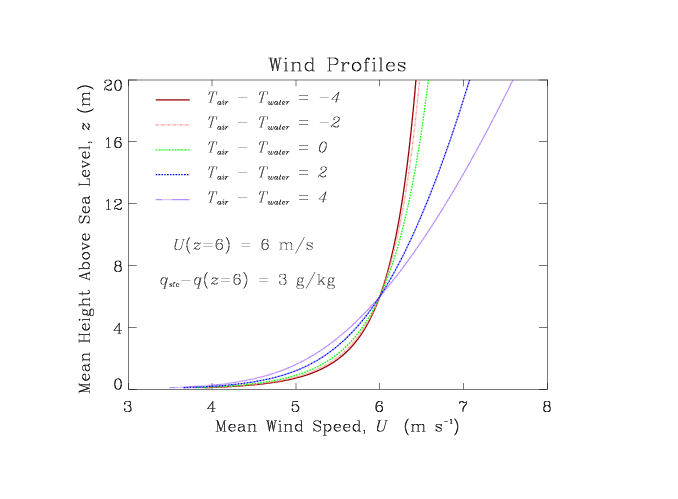What are Wind, Pseudostress, and Stress?
Each of these forcing quantities have been used in ocean and atmospheric modeling. Wind velocity, pseudostress, and stress are all vector quantities with two horizontal components. Typically these components are given as east-wind (positive eastward), and north-south (positive northward). Despite these similarities, the units, magnitude, and meaning differ greatly. The following is a brief tutorial that some users of our products might find useful. The following table can be used to convert the data sets we provide to the input required by ocean and atmospheric models.
| MKS Units | Type | Common Symbols | Definition | Alternative | Alternative | |
| Wind speed | m/s | Scalar | w | w = | | | |
w = (UW^2 + VW^2)^(1/4) | |
| Wind velocity | m/s | Vector |  = u,v = u,v |
u=UW/w | v=VW/w | |
| Pseudostress | m2/s2 | Vector | UW | UW =  w w |
UW = | | |  |
|
| Friction Velocity | m/s | Vector |  |
 = =  |
||
| Kinematic Stress | m2/s2 | Vector |  |
 = =  |
 = =  |
 = =  |
| Stress | N/m2 | Vector |  |
 = =  |
 = =  |
 = =  |
Density of the medium (air in this context). WARNING: using the wrong density results in a factor of 800 error.
CD drag coefficient.
WindWind is the velocity at which the air moves. Since the wind speed changes as a function of height, the height to which the winds correspond must be known. For example, our scatterometer wind products are referenced to a height of 10m. Often, the height is shown in a subscript following the wind symbol, e.g., u10. The following figure shows how atmospheric stability (i.e., stratification of air near the surface) influence the wind profile (Bourassa et al. 1999). In this example, the differences between surface and atmospheric moisture (q) is fixed at 3 g/kg, causing the profile with a zero temperature difference to be slightly unstable.

Strictly speaking, scatterometers are used to determine equivalent neutral wind [Tang and Liu 1996; Verschell et al. 1999] rather than wind; the directions are equal, and wind speed is usually within 0.5 ms-1 of equivalent neutral wind speed. The conversion between wind and equivalent neutral wind requires knowledge of the stability (i.e., stratification) of the air near the surface. This information is not remotely sensed coincidentally with the scatterometer observations; therefore, the conversion to wind is rarely made. More information on the differences between winds and equivalent neutral winds, and the influence of atmospheric stability is available.
PseudostressPseudostress is the product of the wind vector and the wind speed. It is similar to a kinematic stress, hence the name pseudostress. The difference between kinematic stress and pseudostress is a factor equal to the drag coefficient (CD). Unlike stress, and similar to wind, pseudostress changes as a function of height above the surface; consequently, pseudostress must be referenced to a height. For example, our scatterometry based pseudostress products are referenced to a height of 10m.
Friction velocityFriction velocity is a very important term in some models of air-sea interaction. It can also be estimated through remote sensing of water surfaces: NSCAT observations can be used to calculate friction velocity as an alternative to wind speed. Since friction velocity is the square-root of the kinematic stress, these observations can easily be used to estimate the stress. Close to the surface, friction velocity is not a function of height. Furthermore, for modeling purposes, it is the near surface value that is of interest. An observed friction velocity is a great advantage over wind (and equivalent neutral wind) because the dependence on atmospheric stability is (in theory) contained in the observation, and does not require an adjustment dependent on atmospheric stability (Bourassa et al. 1999).
Kinematic StressKinematic stress is the stress per unit density. On the atmospheric side of the air-sea interface, kinematic stress is the stress divided by the density of air. Air-sea interaction can easily be modeled in terms of friction velocity, which can easily be relative to kinematic stress. The magnitude of the square of the friction velocity is equal to the magnitude of the kinematic stress, and the direction of the friction velocity is equal to the direction of the stress. In other words, the kinematic stress is the product of the friction velocity and the magnitude of the friction velocity.
StressSurface stress is the momentum flux through the air-sea interface. One common interpretation is the vertical transfer of horizontal momentum, per unit area. Stress is approximately constant with height near the surface; unlike wind speed there is no need to specify a reference height. Ocean models often use winds to determine stresses, and in turn use these stresses to force ocean currents. In determining NSCAT stresses, a constant density is assumed in the conversion of scatterometer based friction velocity to stress.
As with friction velocity, stress is not a function of height, and it is the near surface value that is of interest in modeling. Stress has a great advantage over wind (and equivalent neutral wind) because the dependence on atmospheric stability is (in theory) contained in the observation, and does not require an adjustment dependent on atmospheric stability.
ReferencesBourassa, M. A., D. G. Vincent, W. L. Wood, 1999: A flux parameterization including the effects of capillary waves and sea state. J. Atmos. Sci., 56, 1123-1139.
Tang, W., and W. T. Liu, Equivalent Neutral Wind, JPL Publication 96-17, 1996.
Verschell, M. A., M. A. Bourassa, D. E. Weissman, and J. J. O'Brien, 1999: Model Validation of the NASA Scatterometer Winds. J. Geophys. Res., 104, 11,359-11,374.

